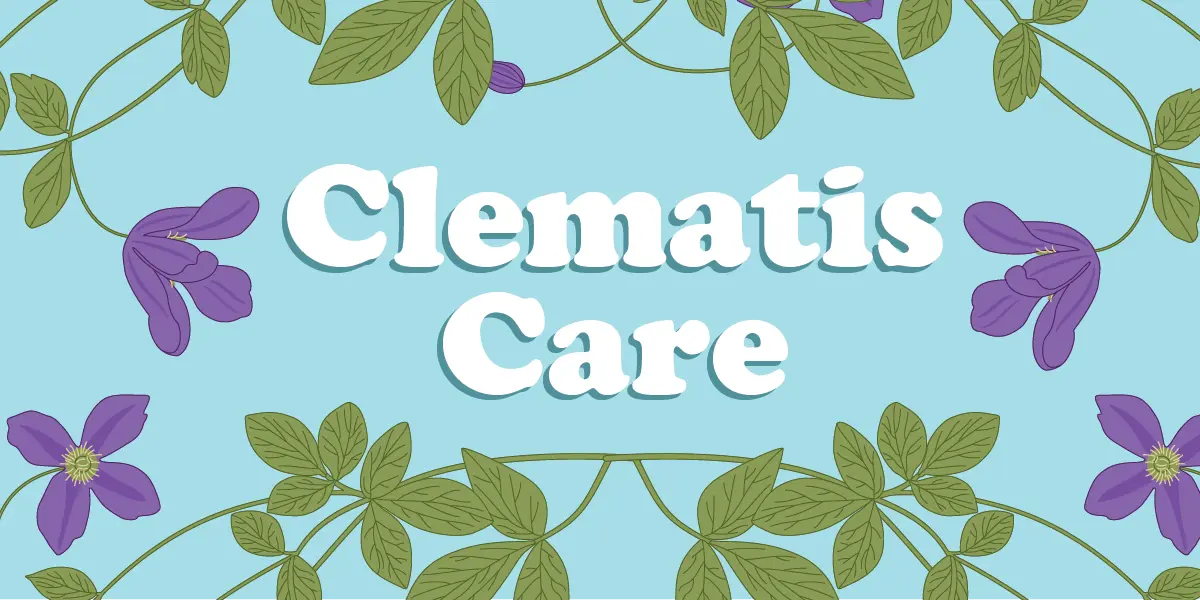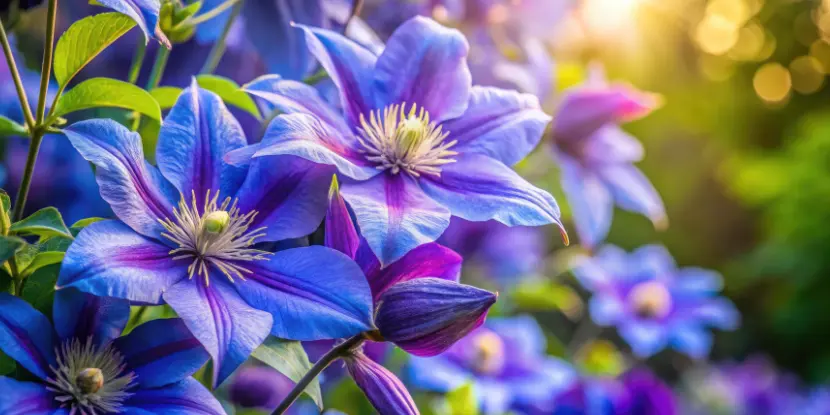Clematis, the “queen of climbers,” is a favorite among gardeners for its stunning blooms and versatile growing habits. Understanding clematis care can transform your garden into a spectacular floral display.
Clematis plants originated in China, Japan, and parts of Europe and belong to the Ranunculaceae family, which includes buttercups and anemones. Over time, breeders developed a wide array of hybrids. The vines can grow up to 20 feet tall and have large, showy flowers ranging from white and pink to purple and blue.
The plant is a perennial that returns year after year and can flourish for decades in the right conditions. It goes dormant during the winter and reemerges in the spring in a riot of color.
Southern California’s mild climate is ideal for clematis, but it can also be grown in most temperate regions.
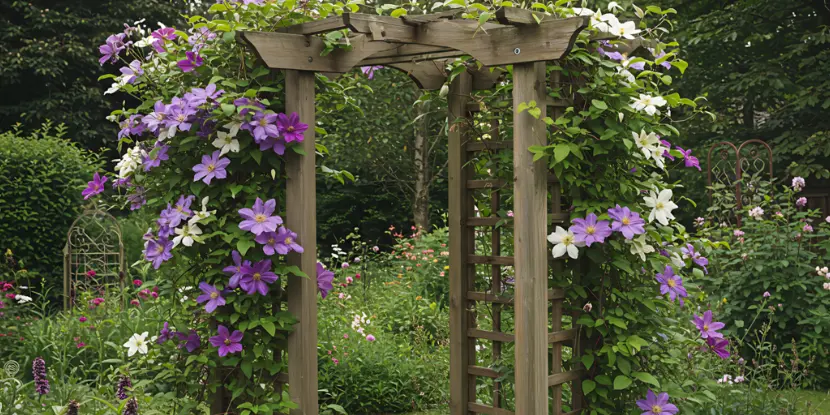
A clematis vine climbs a garden arbor.
Choosing the Right Clematis Variety
There are over 300 clematis species, each with distinct characteristics and requirements. When selecting a variety for your garden, consider the following:
- Flower color and shape: Clematis colors range from white and pink to deep purple and blue. Some varieties have unique flower shapes, such as bell-shaped or delicately ruffled blooms.
- Bloom time: Different clematis varieties bloom at different times of the year. Some bloom in early spring, while others flower in late summer or fall.
- Vine size: Clematis vines vary from small and compact to large and vigorous. Consider the space in your garden before choosing a variety.
- Sun exposure: Most clematis plants prefer full sun to partial shade, but some varieties do well in shady areas.
Best Varieties for Southern California
Not all clematis varieties thrive in hot climates. Here’s a list of heat-tolerant options that perform well in Southern California:
- Clematis armandii (Evergreen Clematis): Known for its scented, star-shaped white flowers and evergreen foliage.
- Clematis texensis (Scarlet Clematis): Bears large bell-shaped flowers that add a bold statement to your garden.
- Clematis Viticella (Italian Clematis): Features delicate purple or mauve blooms that are heat-resistant and easy to grow.
- Clematis ‘Jackmanii’: A classic variety with deep purple flowers that’s perfect for Southern California’s climate.
- Clematis durandii (Ground Clematis): A non-climbing but equally stunning option with deep blue flowers.
Optimal Growing Conditions for Clematis
Light
- Most clematis varieties need at least 6 hours of direct sunlight daily.
- White and light-colored clematis can benefit from some afternoon shade in hot climates.
- Avoid planting in areas with excessive artificial light or bright streetlights, which can disrupt the plant’s natural blooming cycle.
Temperature
- Most clematis varieties prefer cooler temperatures, ideally between 55°F and 75°F.
- Heat-tolerant varieties can thrive in temperatures above 80°F, provided their roots are kept cool and receive afternoon shade.
- During colder months, clematis can survive frost and temperatures as low as 20°F, though extreme freezing conditions may require additional protection, such as mulching.
Soil
- Clematis do best in well-draining soil with a neutral pH (6.5-7.0).
- Amend heavy clay soils with compost to improve drainage.
- Apply mulch around the base of the plant to retain moisture and keep roots cool.
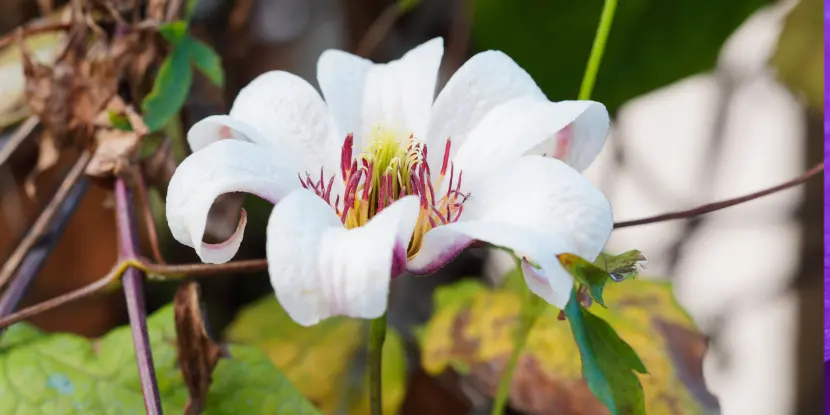
Clematis texensis bears bell-shaped flowers.
Propagating Clematis
Propagating clematis is a cost-effective way to multiply your plants. The easiest methods include layering and taking cuttings.
Layering (Recommended for Beginners)
- Select a healthy stem near the ground.
- Bend it into a small trench, leaving the tip above the soil and pinning the stem.
- Cover with soil, water lightly, and wait for roots to form. Usually, this takes a few months.
Softwood Cuttings (for the Ambitious Gardener)
- Cut a healthy 4–6 inch stem just below a node.
- Remove the lower leaves and dip the end in rooting hormone.
- Plant in a moist potting mix and place in indirect sunlight until roots develop.
Planting Clematis Step-by-Step
- Choose a location with full sun and well-draining soil.
- Dig a hole twice as wide and deep as the root ball.
- Mix compost with the native soil to fill the hole.
- Gradually backfill the hole, ensuring the crown (where the stems meet the root) is 2–3 inches below ground level.
- Install a trellis or support system at planting to guide growth.
- Water thoroughly after planting.
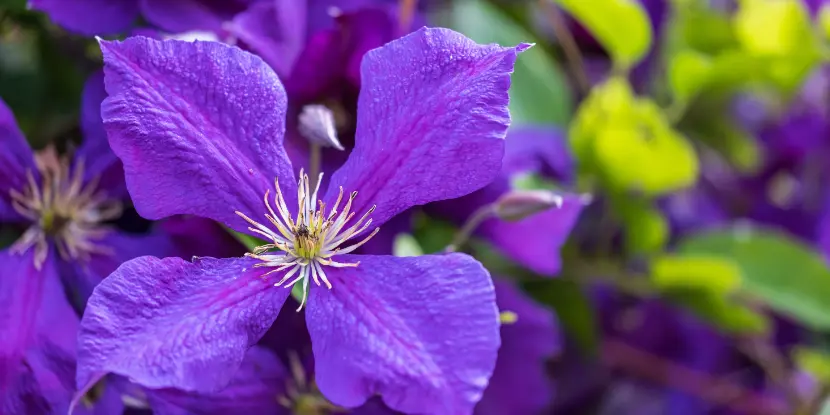
Clematis Viticella features delicate purple or mauve blooms that are heat-resistant and easy to grow.
Clematis Care
Water
- Water deeply and regularly during the first year to help the plant establish its root system.
- Once established, water 1–2 inches per week, depending on rainfall and temperature.
- Avoid overhead watering, which can cause disease.
Fertilizer
- Feed in early spring with a balanced fertilizer.
- Use a high-phosphorus formula when planting to encourage root growth.
Pruning
- Most clematis varieties need pruning to promote healthy growth and flower production.
- Prune in late winter or early spring when the plant is still dormant.
- Remove any dead or damaged stems, then trim back the remaining stems to 12–18 inches above ground level.
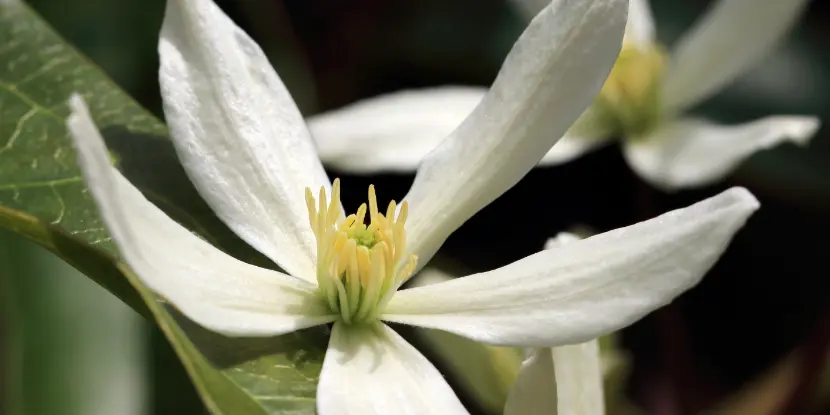
Clematis armandii has scented, star-shaped white flowers and evergreen foliage.
Clematis Pests & Diseases
Clematis is generally resistant to pests and diseases, but not immune. The most common issues include:
- Powdery Mildew: A fungal disease manifesting as white powdery spots on the leaves. Regular pruning and proper air circulation can help prevent this.
- Aphids: Small insects that suck sap from new growth, causing stunted or distorted leaves. Use insecticidal soap to manage an infestation.
- Slugs & Snails: These pests feed on clematis leaves, leaving holes and slime trails behind. Handpick them or use organic slug control methods.
Troubleshooting Common Issues
Lack of Blooms
If your clematis isn’t producing flowers, it could be due to:
- Insufficient sunlight. Most varieties require at least 6 hours of direct sunlight daily.
- Over-fertilizing with nitrogen-rich formulas promotes foliage growth at the expense of flowers.
- Improper pruning, as pruning at the wrong time, can remove buds that would have bloomed.
- Lack of water. Clematis need consistent moisture for healthy blooms.
Wilting or Yellowing Leaves
If your clematis leaves are wilting or turning yellow, try these solutions:
- Water regularly and deeply to prevent drought stress.
- Check for root rot caused by overwatering or poorly draining soil.
- Evaluate the location’s sun exposure, as too much shade can cause a lack of energy production in the plant.
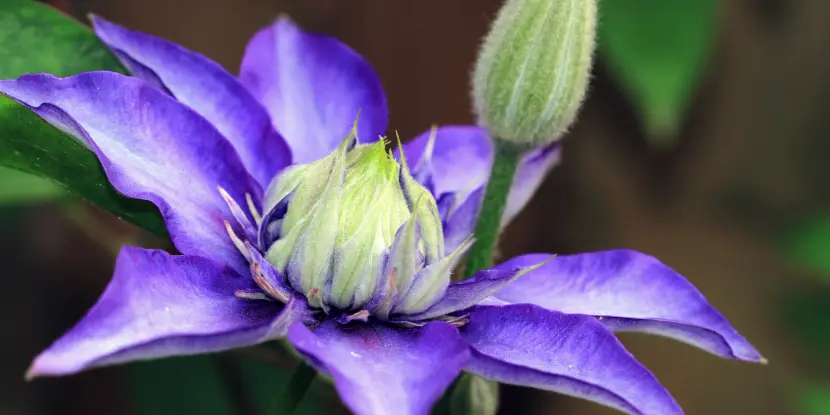
A violet-purple clematis flower.
FAQs: Clematis Care
Q: Can I grow clematis in containers?
Yes. Use large pots (at least 18 inches in diameter), fill with a high-quality potting mix, and provide a sturdy trellis.
Q: Why isn’t my clematis blooming?
This could be due to improper pruning, insufficient sunlight, or nutrient imbalances. Ensure your clematis gets 6+ hours of sunlight, fertilizer, and correct pruning based on its group.
Q: How fast does clematis grow?
Clematis shows moderate growth in the first year. By the second or third year, it blooms abundantly and spreads quickly.
Q: Should I mulch around clematis?
Yes, mulching keeps the soil cool, retains moisture, and prevents weed competition around the plant’s base.
Q: How long does clematis live?
With proper care, clematis can live for 20 years or more, making them a long-term investment in your garden.
Q: Can clematis survive winter?
Most clematis are hardy and survive winters in USDA zones 4–9. In colder months, add a layer of mulch for extra protection.
Q: How do I train my clematis to climb?
Guide its tendrils onto a trellis or other support system early in its growth. Secure loosely with garden ties.
Q: What’s the best time to plant clematis?
The best time to plant clematis is in spring or fall when temperatures are mild, allowing the roots to establish before extreme heat or frost.

